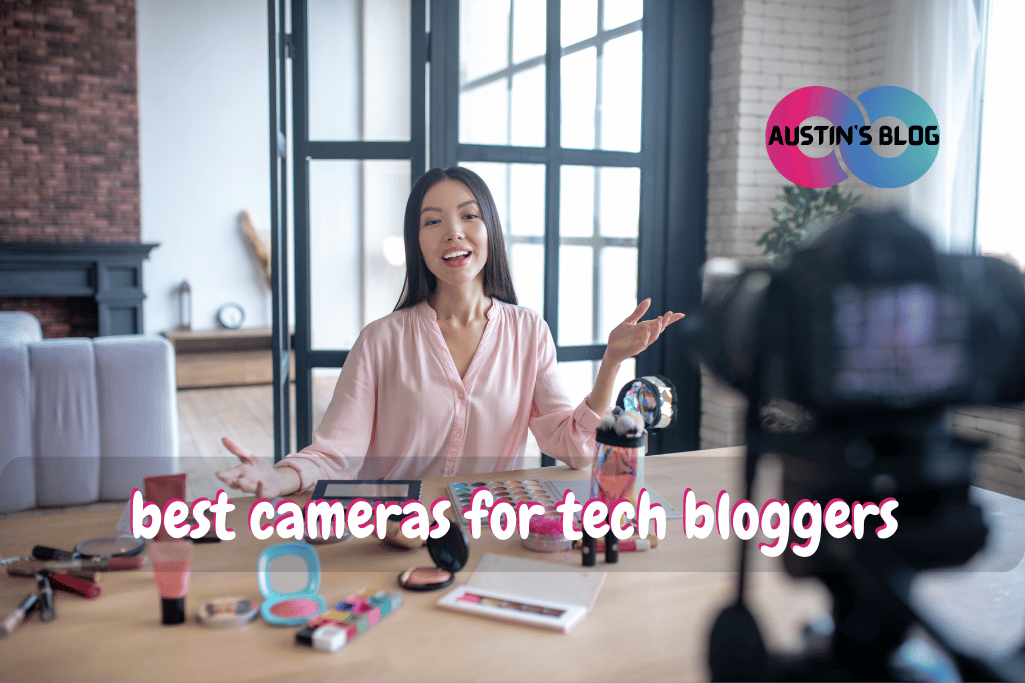Best Cameras for Tech Bloggers: Capturing Gadgets in Their Full Glory
Introduction:
Did you know that posts with images get 94% more views than those without? [1]
That’s right, folks – in the world of tech blogging, a picture isn’t just worth a thousand words; it’s worth thousands of clicks.
But here’s the kicker: most tech bloggers are treating their visual content like it’s an optional accessory, not the killer feature it truly is.
Picture this: you’ve just written a mind-blowing review of the latest smartphone.
Your analysis is sharper than the phone’s OLED display, your insights are deeper than its neural engine, but your photos?
They look like they were taken with a potato. Suddenly, your credibility is crumbling faster than a website without HTTPS.
Trust me, I’ve been there. When I first started my tech blog, my idea of quality photography was propping a gadget against a stack of books and hoping for the best.
My photos were so bad, they could have been used as a captcha test – “Select all images that don’t look like they were taken during an earthquake.”
But then I discovered the power of a good camera, and let me tell you, it was like upgrading from a 56k modem to fiber optic. Suddenly, my blog wasn’t just informative; it was visually stunning.
In this guide, we’re going to explore the best cameras for tech bloggers.
We’ll cover everything from budget-friendly options that punch above their weight to high-end gear that’ll make your gadget shots look better than the manufacturer’s press photos.
Whether you’re shooting unboxing videos, detailed macro shots of circuit boards, or lifestyle images of tech in action, we’ve got you covered.
So, grab your favorite gadget (maybe it’s time to retire it as a photo subject), put on your “I’m about to massively upgrade my visual content” hat, and let’s dive in.
It’s time to transform your tech blog from a wall of text into a visual feast that would make even Jony Ive double-tap that like button!
Smartphone Cameras: The Pocket-Sized Powerhouses
Alright, mobile maestros, let’s start with the camera that’s probably already in your pocket: the smartphone. In the tech blogging world, the best camera is often the one you have with you, and for many of us, that’s our trusty phone.
But not all smartphone cameras are created equal, especially when it comes to the specific needs of tech bloggers.
When I first started, I thought any old smartphone camera would do. I was snapping pics with an ancient iPhone that had more scratches on its lens than a DJ’s vinyl collection.
The results? Let’s just say my gadget shots looked about as crisp as a 240p YouTube video on dial-up.
Here are some top smartphone picks that’ll make your tech blog look sharper than a 4K display:
1. iPhone 13 Pro/Pro Max:
The latest from Apple is a beast for tech photography. Its macro mode is perfect for those close-up circuit board shots, and the ProRAW format gives you serious editing flexibility.
I once used it to capture the intricate details of a mechanical keyboard, and you could practically count the individual switch stems.
2. Google Pixel 6 Pro:
Google’s computational photography is like having an AI assistant for your camera. Its ability to capture accurate colors is crucial for true-to-life gadget shots.
I used it to photograph a lineup of smart home devices, and the colors were so accurate, readers could practically see the difference between “eggshell” and “off-white” smart speakers.
3. Samsung Galaxy S21 Ultra:
With its versatile quad-camera setup, this phone is like the Swiss Army knife of smartphone photography.
The 108MP main sensor is overkill in the best way possible for detailed product shots.
I once used it to capture the texture of a laptop’s aluminum body, and you could almost feel the cool metal through the screen.
4. OnePlus 9 Pro:
Don’t sleep on OnePlus. Their partnership with Hasselblad has elevated their camera game significantly.
The natural color calibration is perfect for accurate tech product representation.
My review photos of colorful gaming peripherals looked so good, readers accused me of using professional lighting (spoiler: I didn’t).
5. Sony Xperia 1 III:
For the video-focused tech blogger, Sony’s offering is hard to beat. Its Cinema Pro mode gives you manual control that rivals dedicated cameras.
I used it to film a detailed teardown of a gaming PC, and the footage looked like it could have been used in a Hollywood tech thriller.
Here’s a pro tip:
Invest in a good smartphone tripod and a clip-on lens kit.
I use a flexible tripod that can wrap around objects for unique angles, and a macro lens attachment for those super close-up shots of tiny tech details.
It’s like giving your smartphone camera superpowers.
Remember, the goal is to capture clear, accurate images of tech products that complement your written content.
I learned this lesson when I tried to show the thinness of a new ultrabook by balancing it on its edge.
Without a steady hand (or a tripod), it looked more like a blurry rectangle than a cutting-edge laptop.
But here’s the catch – don’t let the convenience of smartphone cameras make you lazy with your photography.
I once fell into the trap of thinking “good enough” was fine for my blog. Now, I treat every shot like it’s going on a billboard in Times Square.
Your approach to smartphone photography should feel like you’re carrying a professional studio in your pocket.
It should lead to those “I can’t believe this was shot on a phone!” moments, not the “What am I even looking at?” moments.
And most importantly, it should allow you to capture great images anytime, anywhere inspiration (or a new gadget) strikes.
So, pull out that smartphone, download a few photography apps, and start capturing tech in all its glory.
Because in the world of tech blogging, a good smartphone camera isn’t just a tool – it’s your secret weapon for creating visually stunning content on the go.
Let’s turn those pocket computers into portable photo studios!
Mirrorless Cameras: The Tech Blogger’s Best Friend
Alright, image innovators, it’s time to step up our game and talk about the darling of the modern photography world: mirrorless cameras.
For tech bloggers looking to take their visual content to the next level, mirrorless cameras offer the perfect blend of image quality, versatility, and portability.
It’s like having a DSLR and a point-and-shoot camera had a baby, and that baby grew up to be a tech-loving superhero.
When I first made the jump from smartphone to mirrorless, it was like I’d been given a pair of tech-seeing glasses.
Suddenly, every gadget I photographed looked like it was ready for the cover of Wired.
No more grainy, poorly lit shots of graphics cards that looked more like abstract art than computer components.
Here are some top mirrorless picks that’ll make your tech blog look sharper than a laser-cut chassis:
1. Sony Alpha A7 III:
This full-frame powerhouse is like the Swiss Army knife of cameras. Its excellent low-light performance is perfect for those moody shots of RGB-lit gaming setups.
I once used it to capture a dimly lit server room, and you could practically count the blinking LEDs.
2. Fujifilm X-T4:
With its gorgeous color science and film simulations, this camera makes tech look sexy. It’s great for lifestyle shots of tech in use.
My photos of a smartwatch in action looked so good, readers could almost feel the haptic feedback through the screen.
3. Canon EOS R6:
Canon’s dual pixel autofocus is like having an AI assistant for your camera. It’s fantastic for video work, making it ideal for tech reviewers who do a lot of talking-head shots.
I used it for a series of tech unboxing videos, and the focus was so crisp, viewers could read the fine print on the packaging.
4. Nikon Z6 II:
This camera’s robust build and weather sealing make it perfect for tech bloggers who like to test gadgets in the wild.
I took it on a rugged outdoor tech gear review, and it handled the elements as well as the adventure-proof gear I was testing.
5. Panasonic Lumix GH5:
For the tech bloggers who are serious about video, this micro four-thirds camera is a dream.
Its 4K capabilities and endless customization options make it perfect for detailed tech reviews.
I used it to film a complex PC build, and the footage was so clear, viewers said they felt confident enough to build their own.
Here’s a pro tip:
Invest in a good macro lens. I use a 90mm macro for those ultra-detailed shots of circuit boards, screen pixels, and texture comparisons.
It’s like giving your readers a microscope for tech.
Remember, the goal is to capture images that not only show the tech but tell a story about it.
I learned this lesson when I spent hours trying to get the perfect straight-on shot of a laptop, only to realize that an angled view with the screen displaying vibrant content was much more engaging.
But here’s the catch – don’t let all the features of a mirrorless camera overwhelm you.
I once got so caught up in trying every setting that I missed the perfect lighting for my shoot.
Now, I master a few key settings at a time, slowly expanding my technical knowledge alongside my creative vision.
Your approach to mirrorless photography should feel like you’re painting with light and technology.
It should lead to those “I can see every detail!” moments, not the “This looks just like the press photos” moments.
And most importantly, it should allow you to express your unique perspective on tech through your images.
So, pick up that mirrorless marvel, play with those manual settings, and start capturing tech in ways that will make your readers feel like they can reach out and touch the gadgets through their screens.
Because in the world of tech blogging, a good mirrorless camera isn’t just a tool – it’s your passport to creating professional-grade visual content that will set your blog apart from the crowd.
Let’s make some photographic magic!
Action Cameras: For Tech in Motion
Alright, dynamic documentarians, let’s shift gears and talk about a category of cameras that’s perfect for capturing tech in action: action cameras.
In the world of tech blogging, sometimes you need to show gadgets doing what they do best – performing in the real world, often in conditions that would make a regular camera shake in its lens cap.
When I first got my hands on an action camera, I felt like I’d been given a superpower. Suddenly, I could take my readers on a POV journey through the tech world.
No more static shots of drones – now I could show the actual flight from the drone’s perspective. It was like upgrading from watching tech on TV to experiencing it in VR.
Here are some top action camera picks that’ll add a dose of adrenaline to your tech blog:
1. GoPro HERO10 Black:
The king of action cameras, this little powerhouse is perfect for showcasing rugged tech in extreme conditions.
I once strapped it to a smartwatch during a mountain bike ride to test both the watch’s fitness tracking and its durability.
The footage was so smooth, viewers felt like they were right there on the handlebars.
2. DJI Action 2:
This modular marvel is like the transformers of the camera world. Its magnetic mounting system is perfect for creative angles on tech reviews.
I used it to create a timelapse of a 3D printer in action, easily moving the camera from a wide shot to extreme close-ups of the printing process.
3. Insta360 ONE R:
With its interchangeable lens system, this camera is as adaptable as a Swiss Army knife. The 360-degree module is fantastic for immersive tech environment tours.
I once used it to capture a full smart home setup, allowing viewers to pan around and explore every connected device in the space.
4. Sony RX0 II:
Don’t let its tiny size fool you – this camera packs a 1-inch sensor for superior image quality.
It’s great for high-quality POV shots in tight spaces. I used it to film the interior of a custom water-cooled PC build, getting into nooks and crannies a regular camera could never reach.
5. AKASO Brave 7 LE:
For the budget-conscious tech blogger, this camera offers great bang for your buck. Its front-facing screen is perfect for vlogging-style tech reviews.
I used it for a series of on-the-go gadget tests, easily framing myself and the tech in shot without any guesswork.
Here’s a pro tip:
Get creative with mounts.
I once used a chest mount to film a “day in the life” video with various wearable tech, giving viewers a literal POV of how these gadgets integrate into daily life. It’s like turning your tech reviews into a first-person tech adventure game.
Remember, the goal is to show tech in real-world scenarios, often in motion or extreme conditions.
I learned this lesson when I tried to review a rugged smartphone with static indoor shots.
The moment I took it outside and filmed it surviving a drop test and water submersion, engagement on my blog skyrocketed.
But here’s the catch – don’t let the durability of action cameras make you reckless with expensive tech.
I once got a bit too enthusiastic testing a “waterproof” smartwatch and ended up with an expensive paperweight.
Now, I always double-check IP ratings and warranty terms before any extreme testing.
Your approach to action camera use should feel like you’re inviting your readers on a tech adventure.
It should lead to those “Wow, I never thought of using it like that!” moments, not the “Why is this footage so shaky?” moments.
And most importantly, it should showcase tech performing in real-world conditions, adding a layer of authenticity to your reviews.
So, strap on that action camera, think outside the box for mounting options, and start capturing tech in ways that will make your readers feel like they’re right there with you, experiencing the latest gadgets in all their glory.
Because in the world of tech blogging, a good action camera isn’t just for extreme sports – it’s your ticket to creating dynamic, engaging content that brings tech to life.
Let’s add some action to those tech reviews!
Conclusion:
And there you have it, visual virtuosos – your comprehensive guide to choosing the perfect camera for your tech blog.
We’ve journeyed through the realms of smartphone photography, mirrorless marvels, and action-packed adventures, equipping you with the knowledge to capture tech in all its glory, whether it’s sitting pretty on a desk or soaring through the skies.
Remember, the best camera for your tech blog isn’t necessarily the most expensive or the one with the most megapixels. It’s the one that fits your specific needs, workflow, and the type of content you create.
Whether you’re shooting detailed macro shots of circuit boards, creating immersive smart home tours, or filming high-octane gadget reviews, there’s a perfect camera out there for you.
As you embark on your quest to upgrade your visual content, keep in mind that great tech photography and videography is about more than just the gear.
It’s about understanding light, composition, and how to showcase the unique features of each piece of tech you’re covering.
It’s about telling a visual story that complements and enhances your written content.
And here’s a final piece of advice: don’t be afraid to experiment. Some of the most engaging tech content comes from thinking outside the box.
Try unusual angles, play with lighting, or use your tech products in unexpected ways. Your unique perspective is what will set your blog apart.
Now, I want to hear from you! What cameras have you found most useful for your tech blog?
Any creative shooting techniques you’ve discovered? Or maybe you have questions about capturing a specific type of tech? Drop your thoughts in the comments below.
Let’s turn this into a collaborative masterclass on tech visual content creation!
Remember, every stunning tech photo or video you’ve admired started with someone deciding to up their visual game.
With the right camera, a bit of creativity, and the strategies we’ve discussed, there’s no reason your tech blog can’t become a visual feast that keeps readers coming back for more. Who knows?
Your next shot might just be the one that makes even the most jaded tech enthusiast say, “Wow, I need to see that in person!”
So, pick up that camera, set up that shot, and start capturing tech in ways that will make your readers feel like they’re getting a private, hands-on demo of the latest and greatest gadgets.
Here’s to your success in the exciting world of tech visual content.
May your focus be sharp, your lighting be perfect, and your tech always be ready for its close-up. Happy shooting!
Frequently Asked Questions: Best Cameras for Tech Bloggers
Q: What is the best camera for vlogging in 2025?
A: The best camera for vlogging in 2025 depends on your specific needs, but popular choices include the Sony ZV-E10 for its excellent video capabilities and the Canon PowerShot G7 X Mark III for its compact size and great image quality.
Q: Which camera is recommended for blogging in 2025?
A: For blogging in 2025, the Canon PowerShot G7 X Mark III is highly recommended due to its compact design and high-quality photo and video capabilities, making it ideal for content creators.
Q: What features should I look for in a camera for vlogging?
A: When choosing a camera for vlogging, consider features like 4K video recording, image stabilization, a good microphone, and a flip screen for easy framing. Battery life and portability are also important for vloggers on the go.
Q: Is the DJI Osmo Pocket 3 a good choice for vloggers?
A: Yes, the DJI Osmo Pocket 3 is a great choice for vloggers who want a compact camera with excellent stabilization and 4K video capabilities. It’s perfect for those who need a versatile camera that’s easy to carry.
Q: What is a good budget camera for vlogging in 2025?
A: The Canon PowerShot G7 X Mark III is one of the best budget cameras for vlogging in 2025, offering a balance of quality and affordability. It provides excellent video quality and is suitable for beginners and experienced vloggers alike.
Q: How important is image stabilization for vlogging?
A: Image stabilization is crucial for vlogging as it helps produce smooth, professional-looking videos, especially when shooting handheld or on the move. Cameras with in-body image stabilization or gimbals are highly recommended.
Q: What makes the Sony ZV-E10 a popular choice for vloggers?
A: The Sony ZV-E10 is popular among vloggers due to its APS-C sensor, excellent video quality, and features tailored for content creators, such as a directional microphone and a flip-out screen. It’s designed with vloggers in mind.
Q: Can I use a micro four thirds camera for vlogging?
A: Yes, micro four thirds cameras are a good option for vlogging. They offer a balance of size and performance, with many models providing excellent video quality and interchangeable lenses for versatility.
Q: What is the best compact camera for vlogging in 2025?
A: The Canon PowerShot G7 X Mark III is considered one of the best compact cameras for vlogging in 2025, thanks to its portability, high-quality video recording, and user-friendly features.
Q: Are there any specific cameras recommended for beginner vloggers?
A: Beginner vloggers might consider the Canon PowerShot G7 X Mark III or the Sony ZV-E10, as both offer user-friendly interfaces, excellent video quality, and features that support learning and growth in video content creation.






